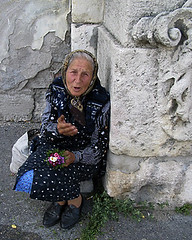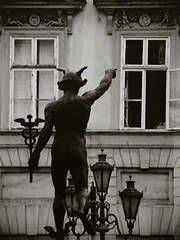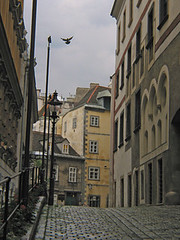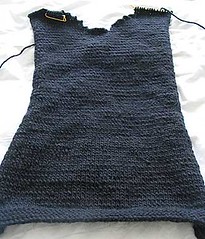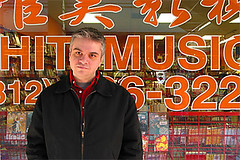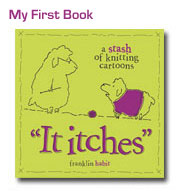I've told this story enough times in person at Stitch 'n' Bitch (where it is of course the second most natural conversation starter after "What are you making?") and for no particular reason except having a little time to kill, I'm going to write it down.
I went to a great big ivy-covered university in Cambridge, Massachusetts with which I had a love-hate relationship. The hate part has been worked through. The love part grew out of finding there people for the first time in my life who actually understood me. Not all of them, of course, but enough so that I no longer felt like The Lone Weird Kid.
Contrary to the popular stereotype, we were not all rich (some of us were - not me), nor were we all geniuses (some of us were - certainly not me). If we did differ from rank and file college students, I think it might have been our affinity for what you could call cozy anachronisms.
For example, my house insisted upon throwing two large parties every year - a waltz party in December, and a swing party in May. Both were black tie. Never mind that maybe twelve people arrived on campus as freshmen knowing how to do either type of dance. It was a tradition, it looked pretty, and so we took lessons and made it happen.
For me, Eliza's knitting fell into the same category as the Lowell House Winter Waltz. I wasn't so much interested in the thing itself as in realizing the mental picture I had of myself doing it.
Eliza herself was a living bit of history, the latest twig on a rich New England family tree old as the hills. Older, perhaps, depending upon which hill you mean. She wasn't matronly or dowdy, but with a slight change of hairstyle she'd have looked perfectly at home in a lace collar and black bombazine skirt, sitting for a portrait by John Singleton Copley. She was the first person my age whom I'd ever seen working a pair of knitting needles, an activity that seemed all of a piece with the rest of her.
It wasn't long before bunches of us were pestering Eliza for lessons. I don't know about the others, but for me knitting seemed to be one more step closer to my youthful fantasy of changing from the ethnic, blue collar boy I'd always been into something much better. Like, say, Abigail Adams. It seems incredibly stupid to me now, but my real motive for going to Harvard wasn't to enjoy access to unparalleled learning opportunities. It was to somehow achieve a racial purification that would render me a candidate for the D.A.R.
(A firm grip on reality has never been one of my strong points.)
Eliza arranged for a group outing to the yarn shop nearby. I remember very little about it, except that the salespeople were not overly friendly. I insisted that I was going to make a sweater, and with Eliza's help selected 6 or 8 hanks of pretty blue yarn. Given that the shop was in Cambridge, most likely it was hand-spun from free-range organically-fed sheep on a lesbian collective somewhere in Vermont. I don't know. I just remember that the cost emptied most of my bank account.
And so needlework evenings began, five or six of us sitting around on beds and chairs. I struggled through the beginnings of a scarf, adding to Eliza's patient "this is a knit, this is a purl" instructions with the diagrams in a cheap teach yourself book I acquired somewhere or other.
I kept at it, even after we got tired of the picture of ourselves knitting around the fireplace like the March sisters. In the first few years after college, I particularly enjoyed being able to knit scarves that met MY definition of what a scarf should be - about nine inches wide, and at least eight feet long. I moved on to mittens, and there I stopped - scarves and mittens, scarves and mittens, for about three years.
Then, gradually, I got discouraged. I have always been a timid person, and trips to the yarn shops in Boston were frightening. My favorite place to go for yarn and embroidery supplies was the Women's Educational and Industrial Union. It's one of those places you're not going to find anywhere in America but Boston. Founded by suffragettes, and run by their spiritual daughters. They were (and I believe still are) in their Victorian-era location, which hadn't changed all that much. Embroidery floss, for example, was dispensed from a gigantic, ornate cabinet with hundreds of tiny drawers in it. The air was hushed, the light deliciously cool and still. I truly loved it, and loved the idea that by shopping there, my money would go to a noble cause.
And every time I went in, I was treated like a rapist.
It didn't matter how often I shopped there, how much I tried to smile and make lighthearted chat, how much I pathetically flashed bits of current projects to show that I was not only serious, but somewhat accomplished (none of the
female embroiderers made their
own patterns, far as I ever saw). They were not having it. I was a freak, and treated as such.
And as for other men to knit with, or women for that matter, forget it. My friends just thought it was odd, and as any knitter reading this will know - nobody care less about your knitting than a non-knitter. And, finally, I wound up spending five years with a partner - the less said of him, the better - who managed to mess with my brain to the point that all my creative projects stopped dead.
When the whole Knitting Craze started, I felt vindicated.
See! I told all you morons this was fun!So here I am again, finally tackling a sweater. And I'm still having bad yarn shop experiences (although in Chicago, this seems to be universal and unisex) but this time, I'm sticking around.
That's my story. What's yours?

